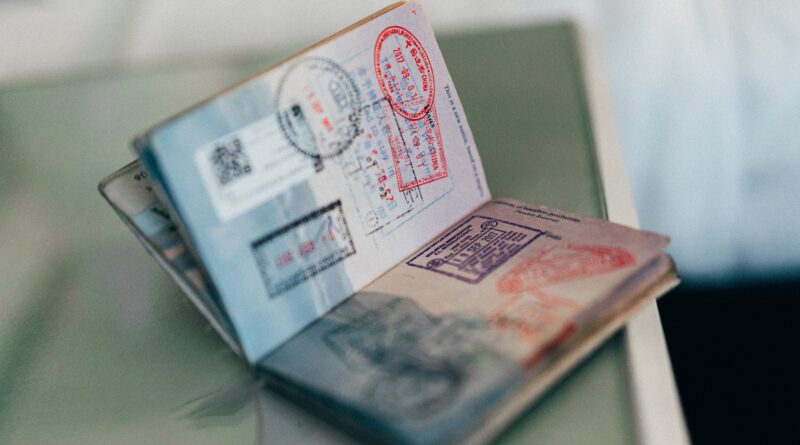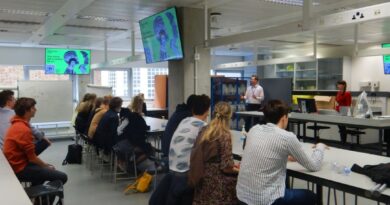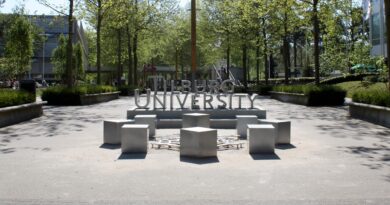The Working Holiday Visa
Many students have always dreamed of temporarily living abroad, meeting all kinds of people from all over the world and gaining tons of incredible experiences in countries such as Australia, Canada and the United States. The Working Holiday Visa (WHV) offers them a great opportunity to realize their dreams. This visa allows them to travel to countries while also being able to apply for a job in the relevant country. At first glance, obtaining such a visa looks like an effortless task, but there is more to it than most people think. What does a WHV exactly involve? What kind of jobs can be applied for using the WHV? And, does the Netherlands also offer such a visa for students? In this Special, these queries will be treated, starting off with the personal story of Keziah, Marjolein and Latisha, four personal friends of Flora.
Written by: Timo van Oorschot and Flora Poon
Keziah, Marjolein and Latisha always had the dream of backpacking. Together with their friend Malou, they chose Australia since the country is well known for its natural beauties and its big cities. The perfect combination for an amazing backpacking trip. They prepared themselves by working for a period of time to finance their trip. Furthermore, they attended multiple information sessions with loads of tips and tricks.
The trip started off with a tour through Indonesia for one month. One day before Christmas, they arrived at their next stop: Sydney. They stayed in an AirBnb for the first two weeks, so that they had enough time to get used to living in Australia. They celebrated New Year’s Eve in Luna Park (Sydney), which they have heard many stories about. In this park visitors had an amazing view of the fireworks over the Sydney Harbour Bridge. After a couple of days of exploring the city, they finally started looking for a job.
Latisha did not want to work on a farm, so she registered herself with multiple employment agencies hoping to find an office job. She applied to multiple companies in Melbourne, but there was no one that accepted her application. After much effort and many interviews, she travelled to Sydney and finally found her first full time job as a receptionist. She had worked there for one and a half months with a salary of twenty one dollars per hour. That may sound like a lot, but in the end, she could not save much money since rent in Sydney is very high.
Keziah and Marjolein went for another approach. They put an advertisement on Gumtree (comparable with ‘Marktplaats’ in the Netherlands) with the message that they were looking for a job, preferably on a farm. At first, nobody responded to their advertisement, so they started side jobs such as working in a kebab restaurant and helping with renovations. After a while, a man called George approached them. He and his friend were looking for au pairs (live-in caretakers) for their children, since the men are miners with shifts of twelve hours a day. Keziah and Marjolein accepted the offer and they moved in with the families to look after their children. Since the families provided them shelter and food, the money they received was minimal. Despite the fact that they earned less, they both enjoyed their stay.
Latisha and Keziah: “If you are really looking for a job to earn money for your road trip, you should look for a job before your trip. The money that we made in Australia is minimal compared to the money we made in the Netherlands.” Marjolein, Keziah and Latisha worked for a short while, since they wanted to get the full experience of living in Australia. Keziah and Marjolein for instance, stayed in a small local village (located in the outback), which gave them a good impression of normal life in Australia.
After two months of working they travelled around with their newly purchased van, which they bought on the website Gumtree. Marjolein: “If you ever come to the point in your life of buying a vehicle in Australia, make sure that you do enough research. In Australia, every vehicle is registered to a certain state with their own policy for the rego (yearly registration including car insurance and road tax). When a car is for example registered in New South Wales, you have to go to a Motor Vehicle Registry in that particular state to extend your rego. Besides, the transfer of ownership of a vehicle also takes place in that particular state. If you do not pay attention, you might buy a car that is registered in another state. As a result, you will have to drive long distances to arrive at an approved Registry.”
Keziah: “We have chosen a van, since it reduces living costs in the long term. We were free to travel to any place we liked and fuel was relatively cheap, even though the distances we had to drive were nothing compared to the distances in the Netherlands.” At night they set up their tents in camping places for a low price or parked their van at a truck stop for free.
Marjolein: “During our trip, we tried to save every penny by taking showers at swimming pools and beach showers. We even brushed our teeth in a Mcdonalds. We often ate canned food in our van, but on special occasions we had dinner in a restaurant. At a given moment we discovered meat pies at gas stations, which was the best food you could get for a low price. I wish that we had discovered this earlier, since the pie was delicious and affordable.” Since Australia is an island, importing fresh fruit and vegetables is relatively expensive. Therefore, it is rather difficult to get proper food for an acceptable price. Especially fast food is a daily go-to, since it is most affordable.
The money they saved was used for big purchases such as travel tours or vacations in other countries. For example Keziah went to New Zealand, Hong Kong, Indonesia and Thailand. Latisha: “Normally when you go on vacation, you make a tight schedule to visit all the touristy places in a country. However, in our case, we had no plan at all. It is the best opportunity to explore all the nearby countries at your own speed. There is no specific location for your stay, since you are carrying your backpack all day. Besides, flight tickets to exotic countries in Asia are relatively cheap. Sometimes there are tickets available to Bali for only one hundred dollars.”
In the end, they worked for approximately two months, travelled for eleven to twelve months and spent more than 13,000 euros per person (excluding the money they made during the trip). Latisha: “I am so thankful I had the opportunity to make this trip with my friends. To me, it sounded scary to go backpacking in Australia since I am not the biggest fan of snakes. However, it turned out that you will not find exotic animals on every corner of the street. Of course, when we went camping once, we had an enormous spider inside our van, but after all, it is nothing compared to the memories I got in return.”
Does this story catch your interest and are you maybe planning to go backpacking yourself, then the remaining part of this article would be useful for you. It will provide all the information needed to apply for a working holiday visa.
The WHV and its purpose
As stated before, the Working Holiday Visa is a special kind of visa that allows travelers to work while staying abroad. They receive a residence permit for a year, being able to stay in the country they applied for. However, the visa expires after 1 year, which means that it cannot be extended by some months or years. By the time the WHV expires, the travelers have to return to their country of origin or they can extend their stay with a standard visa for the country, although they will not be able to apply for jobs and earn some money. The main target group of the WHV consists of students between 18 and 30 years old. Some countries also offer visas for people between 30 and 35 years old, but the focus lies on (prospective) students choosing to take a gap year or already graduated students using an extra year to travel and gain experiences abroad. It is possible to apply for a WHV using a so-called Working Holiday Programme (WHP), which immediately offers some jobs the applicants can choose from. The advantage of these programmes is that students get the chance to travel in groups and get to know each other more easily. However, applying for a WHV while registered at a WHP is not necessary.
The reason why some countries offer these visas is to get students acquainted with the cultural aspects of the country. The two corresponding countries (the country where the student travels to and the country where the student is from) stated this principle in a Memorandum of Understanding. Since not all partnerships of countries have this principle stated in a Memorandum of Understanding, the travel options for students are limited. Therefore, a student in the Netherlands can choose to apply for a WHV in Australia, but not in Indonesia, as these countries do not have an agreement when it comes to visas for working students. [1]
Common restrictions
Currently, you might assume that obtaining a WHV is relatively simple. However, this is not the case. Many WHVs have some restrictions and the applicants must meet certain criteria before they obtain their visa. Although each country has their own rules concerning this, there are some rules that most countries have in common. First of all, as described above, the applicants must be aged 18 to 30(or exceptionally 35). Furthermore, a certain amount of money would have to be demonstrated in order to get the visa. This is a precautionary measure for the fact that students might get into deep debt if they struggle with finding a job or cannot afford a temporary residence. The exact amount of money fluctuates upon each country, but students must take into account that they are obliged to have between 2000 to 5000 euros or dollars in their bank accounts before they go on their adventure. Another rule enforced in many countries is that a WHV can only be obtained once per country and three times in your whole life. Therefore, many travelers describe their adventure as a “once in a lifetime” experience, as they are not able to travel to the same country again in a few years to apply for a job as a student. So, if you are a very adventurous person, you still have the option to use a WHV for different countries with a maximum of three times. Another restriction of the visa is that it is only valid for one year. However, in some countries, an extension of the duration of the visa is possible when specific work has been done for three months or longer. When it comes to work, some countries have a maximum amount of time in which a traveler can work for one employer (six months for example). A reason for this is that continuously staying in one place all the time is prevented in this way. It also gives the students the time to spend their saved money on visiting monuments or events in the country as a part of their holiday, because the holiday part of the visa is also very important. For that reason, you are free to do everything you want outside of these restrictions, as long as the law is obeyed of course. [1][2]
Working Holiday vs. Work and Holiday
The WHV is a visa itself, but within the WHV, there are also some other kinds of visas. As every country has its own visas, the system in Australia is zoomed in on. This is done, because some countries have a very similar system and in Australia, there is quite a difference between some kinds of visas people can apply for. First, we can distinguish the Working Holiday Visa and the Work and Holiday Visa. The names of these visas are quite confusing and most people recognize them as if they are the same, but there are quite some differences. It depends on your country of origin what corresponding visa must be applied for. Most of the time, students from the countries that have best developed speaking the important languages (English, Spanish, Chinese, etc.) are eligible for a Working Holiday Visa. The other countries stick to the Work and Holiday Visa. Additionally, the Work and Holiday Visa requires a letter of support from the government of the country of origin, which you can request. This is not necessary for a standard WHV. There is also the possibility that, when applying for a Work and Holiday Visa, a motivation letter from the student is asked. The main focus when checking this letter lies in the use of functional language, to check if the applicant is able to communicate with the local people of the country where the visa is for. Summarizing, it can be concluded that the Work and Holiday Visa is a bit harder to obtain as there are more requirements for it. [3]
A distinction can also be made between a first, second and third visa within the WHV. Students traveling to a country they have never been to before apply for the first visa, which forms a basis of the time they can work there (short-term). After three months working in specified sectors, mainly the tourism sector and the agricultural sector, applicants are eligible for the second visa. This second visa allows the travelers to find work in some extra other sectors as well, as they already gained some working experience abroad and should be able to have a job in other specific sectors as well. Tour guides or instructors of activities are especially popular for students having a second visa. If they do these kinds of jobs for six months, they are eligible for the third visa, which gives the travelers even more freedom when searching for a job. Furthermore, the third visa may allow an extension of the WHV by three months if work in the specific sectors (for the first visa) is done for three months or longer. Therefore, this is a constructive system where the third visa can be worked towards, which makes it attractive for other countries to use this system as well. [4]
Applying for a WHV
If a traveler wants a WHV and knows about the restrictions and rules of the country, the last step of obtaining the WHV is the application for it. To describe this process, The Netherlands is taken as an example, as The Netherlands also offers WHVs for students from abroad. The first step of applying is filling in a form on the site of the Immigration and Naturalisation Service (IND), which each country has. This form contains some questions about the applicant’s origin, purpose of visiting the Netherlands and some other data. If the applicant lives in a specific country, it is possible that he/she is asked to visit the Dutch embassy in the relevant country for a proof of pre-registration. After filling in the form and, optionally, obtaining a proof of preregistration, the applicant is asked to fill in the date of entry and the location where the residence permit will be collected. These can both be changed according to preferences. Afterwards, it is asked to confirm that the applicant is financially able to live abroad. In the Netherlands, this is done by uploading a return ticket in combination with a document of the bank account, which proves that the financial means of the applicant are sufficient. Now, the applicant is able to accomplish the payment of the WHV to the IND, which contacts this with him/her. The full application is done now and the waiting time for the delivery of the visa starts. It is important to know for travelers that the residence permit shall take effect after the day they visit the Netherlands (or the other country) for the first time, and not the day they receive the WHV in their own country. Finally, the applicants are ready to go on their adventure! [5][6]
These are some final tips from Keziah, Marjolein and Latisha for future backpackers:
- Look for backpack communities on social media
Here you can meet fellow backpackers and share helpful tips. - Save enough money
Since there are many uncertainties involved in backpacking, there could be unforeseen costs. - Open a local bank account
There are no currency exchange fees and payments are much easier. - Back-up for all photos
In foreign countries it can be easy to lose items such as a camera or a phone. A back-up lowers the risk of losing valuable photos.
References
[1] https://www.rondreis.nl/blog/algemeen/in-deze-landen-krijg-je-een-working-holiday-visum-en-hoe-het-werkt/
[2] https://visumbuitenland.nl/australie/whva
[3] https://www.australianskilledmigration.com.au/working-holiday-vs-work-holiday/
[4] https://immi.homeaffairs.gov.au/visas/getting-a-visa
[5] https://ind.nl/en/Documents/FAQ_WHPWHS_en.pdf
[6] https://bckpckr.nl/aanbevolen/working-holiday-visum-australie-whv-aanvragen-en-tips/




